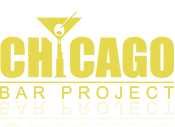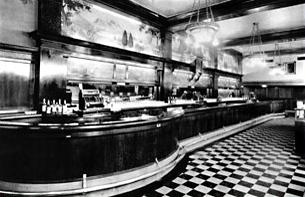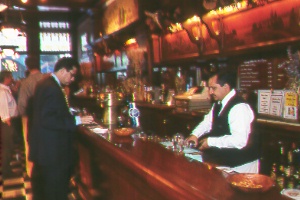INTRODUCING… A CHICAGO LEGEND
 Described by many as “historic,” “a Loop institution,” “a cultural icon,” and a “must see,” few establishments in Chicago, if any, are loved more than 17 West at the Berghoff. Part restaurant, bar, lunch counter, and banquet hall, the Berghoff specializes in serving traditional German fare at reasonable prices to go along with their namesake brew, and has done so for more than a century with its origins dating back to the Columbian Exposition of 1893. Most people today come to Berghoff for Wienerschnitzel, Sauerbraten or a corned beef sandwich, even though the food as well as the saloon itself actually were only meant to help sell more Berghoff beer. As with the recent demise of Marshall Field’s, many feared the loss of the original Berghoff Restaurant in 2006, but it has been reborn as 17 West and is beloved as ever. These days, when restaurants and bars come and go with the changing of the wind, it is truly remarkable that the Berghoff has stayed open for as long as it has, through Prohibition, countless wars, economic downturns, and four generations.
Described by many as “historic,” “a Loop institution,” “a cultural icon,” and a “must see,” few establishments in Chicago, if any, are loved more than 17 West at the Berghoff. Part restaurant, bar, lunch counter, and banquet hall, the Berghoff specializes in serving traditional German fare at reasonable prices to go along with their namesake brew, and has done so for more than a century with its origins dating back to the Columbian Exposition of 1893. Most people today come to Berghoff for Wienerschnitzel, Sauerbraten or a corned beef sandwich, even though the food as well as the saloon itself actually were only meant to help sell more Berghoff beer. As with the recent demise of Marshall Field’s, many feared the loss of the original Berghoff Restaurant in 2006, but it has been reborn as 17 West and is beloved as ever. These days, when restaurants and bars come and go with the changing of the wind, it is truly remarkable that the Berghoff has stayed open for as long as it has, through Prohibition, countless wars, economic downturns, and four generations.
HISTORY AND OTHER LOCATIONS
The Berghoff was originally founded in 1898 by Herman Joseph Berghoff, making it the oldest family run restaurant in the Loop. However, its history goes back even further, to the mid-1800s:
“Grandfather Herman Berghoff came to the U.S. in 1856, then he brought his brothers and a brewmaster from Dortmund to set up shop. In 1887 the Berghoff Brewery was founded in Indiana. They had a saloon tent here in Chicago for two years during the Columbian Exposition of 1893 and liked the city. He tried to get permission to found a brewery here but failed. In retaliation, Herman opened three saloons. One was at Madison and Clark, the second was at Randolph and Halsted, in the building that now houses Barney’s Market Club. The third and surviving saloon was the southwest corner of State and Adams, right next door to the current Berghoff Restaurant.”
– Dennis McCarthy, The Great Chicago Bar and Saloon Guide (1985)
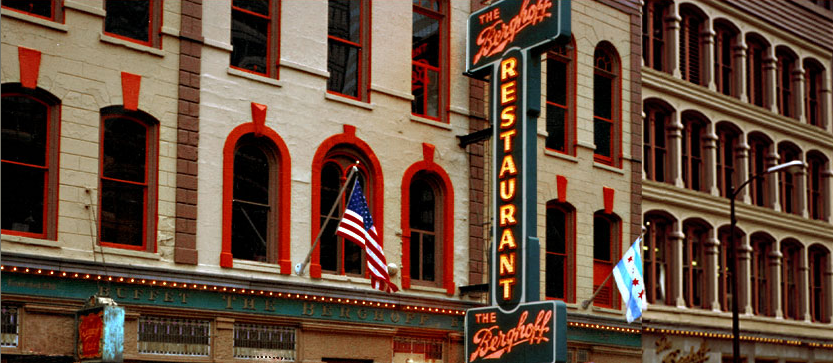
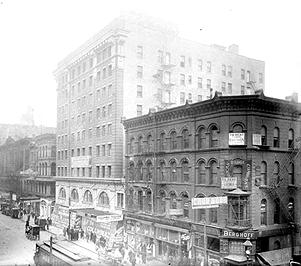 Following the World’s Fair, Berghoff rented out the corner of Adams and State for five years and $175,000. When the lease was up in 1898, he purchased the property next door. By 1914, Berghoff had two additional locations at 166 N. Dearborn and 741 W. Rand. Later, again according to Dennis McCarthy, “During Prohibition the Berghoff Family did a very un-Chicago-like thing: they did not run a speakeasy. Their brewery made beer and extracted the alcohol from it. Maybe that spurred the history of their excellent, reasonably priced food.” As soon as America’s dry spell ended, never mind all the speakeasies, Herman Joseph Berghoff went straight to City Hall and obtained Chicago liquor permit No. 1 in 1933, which is still on display in one the restaurant’s dining rooms.
Following the World’s Fair, Berghoff rented out the corner of Adams and State for five years and $175,000. When the lease was up in 1898, he purchased the property next door. By 1914, Berghoff had two additional locations at 166 N. Dearborn and 741 W. Rand. Later, again according to Dennis McCarthy, “During Prohibition the Berghoff Family did a very un-Chicago-like thing: they did not run a speakeasy. Their brewery made beer and extracted the alcohol from it. Maybe that spurred the history of their excellent, reasonably priced food.” As soon as America’s dry spell ended, never mind all the speakeasies, Herman Joseph Berghoff went straight to City Hall and obtained Chicago liquor permit No. 1 in 1933, which is still on display in one the restaurant’s dining rooms.
While the current location is by far the best known and most successful, the Berghoff family also operates a cafe-like version of the Berghoff at O’Hare. There also used to be a location at 123 N. Wabash that opened in 1968 and, while doing brisk business in the first few years, closed later when business dried up following the Loop’s dramatic downturn in the early 1970s. The Berghoff family also tried opening another location at 432 W. Ontario, which used to be Sieben’s Brewpub but, after this satellite location failed, Reza’s took over and has been doing well ever since with the excellent sampling of Persian food. The current owner, Herman Berghoff, also purchased Tosi’s Restaurant in Michigan’s “Harbor Country” in 1973 but sold it 10 years later.
THE FLAGSHIP
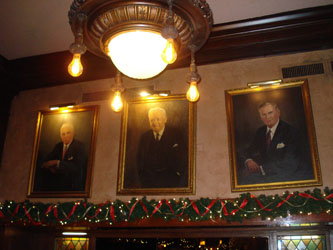 Today’s Berghoff is located on Adams, in-between State and Dearborn in the Loop. Your best bet to get there is to take the Red Line El, get off at Monroe and use the southwest exit. You’ll arrive to street level just north of Adams and around the corner from the Berghoff. You can also get off at the Adams stop for the Brown, Green, Orange and Purple lines. If you’re driving, I recommend parking in the Grant Park North underground garage, which can be found under Millennium Park. Either way, as you round the corner, you’ll see one of the most famous marquees in the Chicagoland area, right up there with the cursive neon Green Mill sign, neon lips of Magikist (now gone) and male & female caveman hotdog combo of Superdawg. “The Berghoff” appears in cursive orange neon with “RESTAURANT” written vertically upon a brown background, the whole of which stretches two stories. The Berghoff consists of what looks like four separate buildings but is actually two – one of which is three stories with high ceilings and the other is four stories high. Both were built following the Great Chicago Fire in 1872 and today sit nestled within much larger buildings, leading a few to believe that the structure may fall to the wrecking ball some day…
Today’s Berghoff is located on Adams, in-between State and Dearborn in the Loop. Your best bet to get there is to take the Red Line El, get off at Monroe and use the southwest exit. You’ll arrive to street level just north of Adams and around the corner from the Berghoff. You can also get off at the Adams stop for the Brown, Green, Orange and Purple lines. If you’re driving, I recommend parking in the Grant Park North underground garage, which can be found under Millennium Park. Either way, as you round the corner, you’ll see one of the most famous marquees in the Chicagoland area, right up there with the cursive neon Green Mill sign, neon lips of Magikist (now gone) and male & female caveman hotdog combo of Superdawg. “The Berghoff” appears in cursive orange neon with “RESTAURANT” written vertically upon a brown background, the whole of which stretches two stories. The Berghoff consists of what looks like four separate buildings but is actually two – one of which is three stories with high ceilings and the other is four stories high. Both were built following the Great Chicago Fire in 1872 and today sit nestled within much larger buildings, leading a few to believe that the structure may fall to the wrecking ball some day…
UPON ARRIVAL
For now, the stone facade is nicely painted in shades of brown with red trimmings, and a row of orange light bulbs keeps the place illuminated at night, as do the old-fashioned brass lanterns. Several plate glass windows at street level display menus as well as an array of merchandise, consisting of Berghoff glasses, steins, beer trays, clocks, t-shirts, sweatshirts, and hats. The main entrance to the restaurant can be found directly under the famous sign, and through a doorway that has a pair of old-fashioned “Berghoff Cafe and Restaurant” signs standing sentry. Because the Berghoff won’t take reservations for parties under five, it is common to find a long-line stretching out the door and down Adams during lunchtime. Once you’re able to get inside, you’ll have to pass through a wooden revolving door, and pass through a hallway that leads off to the right. Then to the right is the maitre d’ stand, where you’ll be seated as swiftly as possible in the dining room to the right of the private party room that once served as a second restaurant area, now the “Century Room,” and closed to the public via a long curtain.
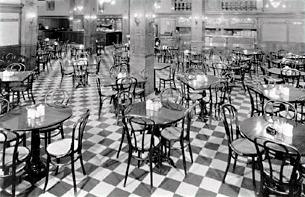 The Berghoff Restaurant in the 1930s
The Berghoff Restaurant in the 1930s
The dining room features enough oak paneling, even on the columns, to make the management of the Walnut Room at Marshall Field’s jealous. Brown & cream colored linoleum tile, numerous low-slung wooden tables with white linen, and brass chandeliers hanging from a beige-colored, 20-foot ceiling rounds out the decor. This space also features framed photographs of old Chicago and the Columbian Exposition from the Chicago Historical Society’s archives, including the Ferris Wheel, invented by George Ferris and unveiled at the World’s Fair. A much smaller version of the original wheel, which held 36 carriages of up to 50 people, can be found today at nearby Navy Pier. A wall of brightly colored stained glass can be found in this room’s northwest corner. Spacious bathrooms can be found down the wooden stairs back in the hallway leading into the main entrance of the restaurant, as well as under the large paintings of three generations of Berghoff men, just to the left of the kitchen.
WHAT EVERYONE’S WAITING FOR
While German favorites garner the most attention at Berghoff, you’ll also find an array of traditional continental European dishes along with steaks and seafood as well, all of which is made from scratch. Starting off, you can choose soup, garlic escargot, smoked salmon, a sausage plate of bratwurst and knockwurst, creamed herring, and there’s a couple of salad options. I’ve been to Berghoff many times and, I must admit, I think I’ve only ordered the wienerschnitzel and it makes me hungry just thinking about it. You see, you don’t just get a lightly fried wienerschnitzel, done properly—you can tell because the breading does not separate from the veal cutlet—but you also get German fried potatoes (more like hash browns), a side of surprisingly good creamed spinach, pickle, and each table features complimentary mustard (superb), sauerkraut and slices of multigrain bread served with real butter. Wunderbar! In my recent visits, I have become a big fan of the rahm schnitzel, which is served almost exactly like the wienerschnitzel, but instead of manually applying lemon juice to the veal, the rahm schnitzel (breaded pork cutlet) is served with an excellent sauce, though somewhat oddly colored orange due to the mix of mushrooms, white wine and tomato sauce. The Berghoff is also widely regarded for its sauerbraten, which is a marinated roast sirloin of beef with sweet and sour gravy, served with spatzle (little twisted bits of fried dough, buttered for good measure). Whatever you order at Berghoff, just make sure you come with an appetite, because you won’t have another perhaps until the next day thanks to all the butter, fat, heavy cream, and carbohydrates… the less you think about it, the better.
“The food is great. The beer is great. The home wine is great. In fact everything about the place is top notch, and over the years, things do not change here.”
– Dennis McCarthy, The Great Chicago Bar and Saloon Guide (1985)
You can also find chicken schnitzel (breaded herb chicken breast served on a bed of stewed tomatoes), broiled brisket of corned beef, schweins filet (medallions of pork sauteed in white wine, mushrooms and tomatoes), roasted young tom turkey with dressing and cranberry sauce, smoked barbecue baby back ribs, braised lamb shank, pot roast (same as the sauerbraten but served with jardiniere, “trio of sausages” (bratwurst, knockwurst and smoked thuringer), the “schlact-platte” (same as the sausage trio, with “kassler rippchen” or smoked pork loin instead of the knockwurst), geshnetzeltes veal with sauteed mushrooms in white wine sauce, veal marsala, and rotisserie-style duckling with lingonberry sauce and wild rice. The smell from all this food in both dining rooms is magnificent!
For some mysterious reason, the Berghoff also features dishes from the sea. You’ll find salmon (broiled, pan-seared and pan-seared cakes with ancho chili sauce), broiled Alaskan halibut, fried shrimp, a seafood brochette of swordfish, tuna, scallops, and shrimp, a “genuine bouillabaisse” consisting of saffron-infused fish stock incorporating lobster, shrimp, clams, mussels, and salmon (served only Thursday through Saturday), and broiled Lake Superior whitefish with fresh tomato-basil-balsamic relish. A few pasta options are also available, but if that’s what you want, I would recommend the Italian Village only a block away on Monroe.
On the dinner menu, you’ll also find a variety of specialty steaks: broiled tournedos “Cafe de Paris” (two petite filets of beef tenderloin), broiled filet mignon, and a 16-ounce, char-grilled Black Angus sirloin steak. Other items like grilled ribeye, broiled halibut livonese (served on a bed of sauteed spinach with white wine, green olives, and caper sauce), jagerschnitzel (pork scaloppini with a rich Jagermeister and applewood smoked bacon sauce), baked salmon in papillote with shiitake mushrooms and sauteed spinach, 16-ounce pork chops (served in Berghoff Bourbon and caramelized onion sauce), shrimp & scallop creole (a broth with white wine and basmati rice), and venison medallions with Cumberland sauce and a plum-blackberry compote. For the coup-de-gras, I recommend the cinnamon-seasoned apple strudel, but the flourless chocolate cake is pretty good too. The restaurant is open until from 11:00am to 9:00pm everyday, except for 11:00am to 9:30pm on Fridays, 11:30am to 10:00pm on Saturdays, and the whole place is closed on Sundays and holidays. Carry out is also available until the ominous February 28th. While the full menu will end at that time, the “Berghoff Family Cookbook” is expected to be published in the Fall of 2007.
“If you can pass up the fine German specialties, you’ll get as good a steak, as fine a fish dish, as can be had anywhere. But who can bypass Sauerbraten that has been marinated in wooden barrels; or one of the four kinds of ragout; or Natur Schnitzel with imported pfifferling; Kassler Rippchen; geschnaetzlets and other schnitzels; or frog legs Orly in a beer batter?”
– Jory Graham, Chicago, an Extraordinary Guide (1967)
CAFE AND SANDWICHES
The Berghoff also features a few sandwich selections: a very popular hot corned beef served with a healthy wad of sauerkraut on rye bread. You can also grab an eight-ounce burger served with sauteed onions, bacon, lettuce, tomato, choice of Swiss, American or cheddar cheese on a Kaiser bun. If a sandwich is all you want, you might want to check out the Berghoff Cafe, especially if you want to avoid standing in line outside at lunchtime. The entrance to the Cafe can be found right next to the main entrance to the restaurant, signified by a small bit of stained glass with “Berghoff Cafe” in black lettering. Walk down a set of stairs to the lower level and you’ll find a wooden paneled hallway, leading you to a nicely-tiled open space with low ceilings held up by brightly, diamond-tiled columns reminiscent of the stained glass windows above. A long, U-shaped, cafeteria-style counter is where you can belly up and order a hand-carved sanger, meat loaf, a brat, corned beef hash, and hard-boiled eggs. Just watch out as confusion ensues when the sandwich people tangle with those out for salad. This option was only available in the bar area of the Berghoff until the lower level was remodeled in 2003. The cafe is open from 11:00am to 2:30pm, Monday through Friday and is closed on the weekends and holidays.
PERHAPS WHAT THE BAR IN HEAVEN LOOKS LIKE?
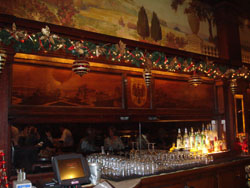 For those more in the mood for drinks, the actual Berghoff Bar can be found next to the entrance to the cafe. This room features a long wooden bar that stretches the entire length of the east wall and which bows out at the north end. For most of its life, the bar never had stools but rather a brass railing on which one could rest, one foot at a time. Rather than the usual array of microbrews, macrobrews and imports, the Berghoff only serves its own beer from about a dozen taps. More hand painted murals can be found above the bar, around an ancient wooden clock, depicting a pair of female minstrels and illuminated by hanging light fixtures that have been in place since the 1950’s. The Berghoff Bar has the distinction of being one of the earliest bars to close in the city, when patrons are chucked out around 8:30pm. Fortunately, the bar opens at 10:30am, which is actually earlier than the restaurant, to help compensate. The lunch menu is available from opening until 2:30pm, followed by a full bar menu until close.
For those more in the mood for drinks, the actual Berghoff Bar can be found next to the entrance to the cafe. This room features a long wooden bar that stretches the entire length of the east wall and which bows out at the north end. For most of its life, the bar never had stools but rather a brass railing on which one could rest, one foot at a time. Rather than the usual array of microbrews, macrobrews and imports, the Berghoff only serves its own beer from about a dozen taps. More hand painted murals can be found above the bar, around an ancient wooden clock, depicting a pair of female minstrels and illuminated by hanging light fixtures that have been in place since the 1950’s. The Berghoff Bar has the distinction of being one of the earliest bars to close in the city, when patrons are chucked out around 8:30pm. Fortunately, the bar opens at 10:30am, which is actually earlier than the restaurant, to help compensate. The lunch menu is available from opening until 2:30pm, followed by a full bar menu until close.
BEER, BREWERY AND BOURBON
As noted earlier, the Berghoff came into being largely to showcase Herman Berghoff’s beer, which started out with Berghoff Lager and which grew into a dozen varieties, most of which were added during the microbrewery boom of the 1990’s, except for the root beer that came into being during the 1950’s and is a descendent of Bergo Soda Pop, sold during Prohibition. Berghoff beer is, “full-bodied, all-malt taste based on an original, 100-year-old family recipe,” according to the Berghoff website. Herman Joseph Berghoff opened his brewery along with his brothers, Henry, Hubert and Gustav in Fort Wayne, Indiana, back in 1887 and, after a successful stint at the World’s Fair, started distributing his brew in Chicago via his original three saloons. When the Berghoff opened, beer was sold for a nickel and sandwiches were given away for free to enhance one’s thirst. Today, Berghoff beer is brewed by the Huber Brewery in Wisconsin, and that is also expected to come to an end when the Berghoff Restaurant closes. For the moment, glass, stein and pitcher are also available in the dining room. Since Prohibition’s end, the Berghoff has also served its own private stock of single-barrel Kentucky bourbon, which is a robust 90 proof and aged 14 years.
“An enormous brass-railed mahogany bar accepts 45 gentlemen comfortably but manages to accommodate three times the number during the lunch and pre-dinner crushes. Famous for its age (pre-turn of the century), its great Berghoff beers, its staunch men-only tradition. Opens at 10 AM daily; closes at 10 PM. Sandwich bar and hard-cooked eggs available.”
– Jory Graham, Chicago, an Extraordinary Guide (1967)
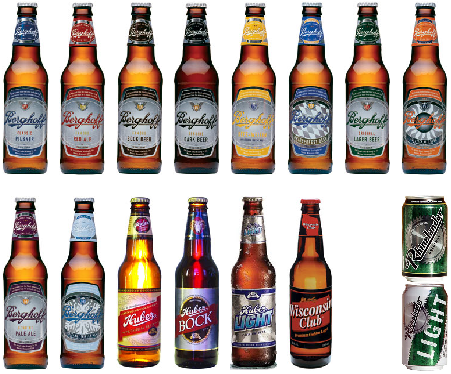
EQUAL RIGHTS (TO STAND, DRINK BEER AND EAT SANDWICHES)
This space became infamous for it’s staunch men-only policy, but the ownership finally relented to the fairer sex in 1969 after a “stand-in” (it would have been a sit-in, but there were no stools at the bar) by seven members of the National Organization for Women where they bellied up to the bar and demanded service. Because change can be painful, the ladies were served but the bartenders refused to call them anything but “Sir.” Barstools were also added around the turn of the Millennium, and sandwiches are still served in the bar, even with the opening of the downstairs cafe.
“I distinctly recall that about 1970 I met one of the women who was among the group which broke the Berghoff bar’s men-only rule the year before. She said that it turned out to be a disappointing event. The women had expected confrontation and fireworks. Instead when they went in, the response was simply to ask for their order. So they just quietly had their beer and sandwiches.”
– George R. on LTHForum.com (May 27, 2004)
CONNOISSEURS OF KRAUT
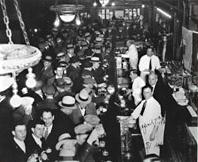 The crowd at the Berghoff is indeed a mixed bag, with the predominant interest coming from men, although even the ladies can appreciate a warm atmosphere, a salad and maybe even the wienerschnitzel. City and state politicians, even the occasional congressman and federal administration official, as well as traders, office workers, tradesmen, conventioneers, and a heap of tourists from all over the world descend upon the Berghoff primarily during lunch or after work, during the week. The Berghoff doesn’t generally attract the usual dinner crowd, as they usually stay north of the river, but does succeed in luring theater-goers, older Germans from neighborhoods like Lincoln Square, as well as suburbanites venturing into the city over the weekends like I used to as a kid with my parents. Even Hizzoner, Richard M. Daley, Mayor, loves the Berghoff and laments the impending loss of the it as tearing at the fabric of Chicago, as do patrons some of which have been going to the Berghoff for over 60 years. Crowds swell from around 1,500 to 3,000 a day around the holidays and into the depths of winter, when the heavy German food is good for the soul. Most come for lunch and after work. While some criticize the Berghoff for curmudgeonly service, declining food quality that never rose above mediocrity, and not serving traditional-enough food, most regard the place highly anyway and come back again and again. The Berghoff won’t win any awards for exemplary or healthy cuisine, or a romantic atmosphere, but generations of patrons keep coming back anyway.
The crowd at the Berghoff is indeed a mixed bag, with the predominant interest coming from men, although even the ladies can appreciate a warm atmosphere, a salad and maybe even the wienerschnitzel. City and state politicians, even the occasional congressman and federal administration official, as well as traders, office workers, tradesmen, conventioneers, and a heap of tourists from all over the world descend upon the Berghoff primarily during lunch or after work, during the week. The Berghoff doesn’t generally attract the usual dinner crowd, as they usually stay north of the river, but does succeed in luring theater-goers, older Germans from neighborhoods like Lincoln Square, as well as suburbanites venturing into the city over the weekends like I used to as a kid with my parents. Even Hizzoner, Richard M. Daley, Mayor, loves the Berghoff and laments the impending loss of the it as tearing at the fabric of Chicago, as do patrons some of which have been going to the Berghoff for over 60 years. Crowds swell from around 1,500 to 3,000 a day around the holidays and into the depths of winter, when the heavy German food is good for the soul. Most come for lunch and after work. While some criticize the Berghoff for curmudgeonly service, declining food quality that never rose above mediocrity, and not serving traditional-enough food, most regard the place highly anyway and come back again and again. The Berghoff won’t win any awards for exemplary or healthy cuisine, or a romantic atmosphere, but generations of patrons keep coming back anyway.
OKTOBERFEST
Some people only know the Berghoff from their annual hosting of Oktoberfest, held in the Loop every September since 1986, except in 2001 due to Wacker Drive re-construction and in 2004 due to “skyrocketing insurance rates.” For three days, Loop office dwellers and those venturing downtown can experience a bit of Bavaria smack dab in the middle of Federal Plaza, wedged in-between Calder’s Flamingo sculpture and the post office. A line of canopies cover up an operation where more bratwurst is fried up than you can shake a stick at, as well as chicken barbequed and corn-on-the-cob boiled. Soft pretzels and cookies can also be ingested. Step up with money in hand, place your order and grab a spot at one of the many makeshift cocktail tables that look like jacked up versions of the picnic variety. As you enjoy your healthy meal, you can experience a line-up of bands that ranges from the traditional oompah variety to rock and even disco. The fest opens at lunchtime and closes around 9pm. With the impending closure of the restaurant, this festival also has an uncertain future. I’m just glad I attended what could have been the last one in 2005.
“The restaurant celebrates four annual festivals: Bock Beer in early spring; May Wine Time, when the fresh young wines that have been steeped in woodruff arrive (they’re served in traditional roemers with fresh strawberries); the Lager Bierfest (October), when the restaurant is decorated in sheaves of barley and bierfest specialties such as Bratwurst, Huhn im Topf and Wiener Rostbraten are added to the menu; and the great season leading to Christmas. This last starts about Thanksgiving, and the restaurant turns into a Graustarkian hunter’s lodge. Up go the greens, the tree, the old-fashioned wreaths. Out come the waiters bearing roast goose, hasenpfeffer, rehpfeffer (venison stew), rehbraten (venison roast), pheasant, clams, oysters. It’s not to be missed.”
– Jory Graham, Chicago, an Extraordinary Guide (1967)
A BRIEF HIATUS AND CHA-CHA-CHA-CHANGES
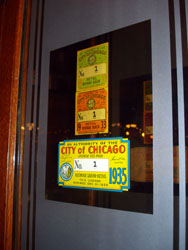 Wednesday, December 28, 2005, was a dark day for Chicago when it was announced that Herman Berghoff, grandson of founder Herman Joseph Berghoff, and his wife Jan, decided to retire and close their restaurant on February 28, 2006 after running it for 20 years. Herman was reported as saying, “We share the sadness that many feel about the closing of the restaurant. It’s been an honor to be part of the fabric of Chicago, but after being in the business for over a half century, Jan and I feel that now is the right time to start a new chapter in our lives.”
Wednesday, December 28, 2005, was a dark day for Chicago when it was announced that Herman Berghoff, grandson of founder Herman Joseph Berghoff, and his wife Jan, decided to retire and close their restaurant on February 28, 2006 after running it for 20 years. Herman was reported as saying, “We share the sadness that many feel about the closing of the restaurant. It’s been an honor to be part of the fabric of Chicago, but after being in the business for over a half century, Jan and I feel that now is the right time to start a new chapter in our lives.”
What may have hastened the retirement of the Berghoffs was that the landlord of the West Loop building, housing their daughter’s Artist Events by Carlyn Berghoff Catering, sold the structure so that it can be renovated into condominiums, leaving Carlyn’s business without a home. Upon its takeover, it was feared that Carlyn would permanently close the Berghoff to the public and run it exclusively as a catering operation, following the remodeling that began the day after the restaurant’s “close.” However, much to the delight of locals and visitors, the Berghoff re-opened a few months later, under its present name, “17 West at the Berghoff,” which reflects its legacy and address on Adams. In addition to the transition from the third to fourth generation of Berghoffs, the temporary closing of the Berghoff conveniently allowed the replacement of all costly union waitstaff with non-union employees.
Fortunately, the remodeling left the restaurant largely intact. The barroom has been expanded and now includes a variety of cocktail tables in addition to the long bar that runs along the eastern wall. A copy of the first liquor license issued by the City of Chicago can be found on one of the mirrors along the western wall. A wooden partition separates the bar area from the dining room, where a dark blue floor-to-ceiling curtain once stood. This was where you could sneak in and snag a table without waiting in line, assuming you graciously tipped your waiter… As for the long lost original waitstaff, they were an army of older, mostly middle-aged German and European men clad in black tuxedos and white aprons, whose tenure at the Berghoff was measured in decades rather than years. Service was brisk, rushed and sometimes abrupt from these career waiters. From Zagat’s (2005/06): “If you haven’t been abused by the waiter, you haven’t had the complete experience.” It’s unclear when this practice came to an end but, for most of the Berghoff’s existence, the waiters operated under a token system, described in this way by Kay Loring in her book, A Chicagoland Restaurant Guide (1978): “Following an old European custom, the waiters buy tokens for the day’s business, use them to pay for food and drink as orders are placed. Then, in turn, they pocket money paid to them by diners.” This method was presumably used to minimize the risk of pilfering given all the cash changing hands.
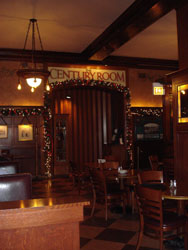 Unfortunately, the better of the two original dining rooms was renamed the “Century Room” and is now closed to the public, serving exclusively as a private party space. This room features a beautiful, hand-painted mural of the Columbian Exposition’s “Court of Honor” consisting of the Peristyle and Grand Basin, which is spread over three separate panels and set next to each other only inches apart. The bright whites and blues of this mural really makes the Columbian Exposition come alive, particularly if you’ve read the book, Devil in the White City by Erik Larson, which gives you a sense for what Larson describes: “The Court of Honor produced an effect of majesty and beauty than even the dream conjured in the Rookery library. Some visitors found themselves so moved by the Court of Honor that immediately upon entering they began to weep.” I had a similar feeling when served my first wienerschnitzel at the Berghoff… If it’s early or not too busy, be sure to pop your head in to check it out.
Unfortunately, the better of the two original dining rooms was renamed the “Century Room” and is now closed to the public, serving exclusively as a private party space. This room features a beautiful, hand-painted mural of the Columbian Exposition’s “Court of Honor” consisting of the Peristyle and Grand Basin, which is spread over three separate panels and set next to each other only inches apart. The bright whites and blues of this mural really makes the Columbian Exposition come alive, particularly if you’ve read the book, Devil in the White City by Erik Larson, which gives you a sense for what Larson describes: “The Court of Honor produced an effect of majesty and beauty than even the dream conjured in the Rookery library. Some visitors found themselves so moved by the Court of Honor that immediately upon entering they began to weep.” I had a similar feeling when served my first wienerschnitzel at the Berghoff… If it’s early or not too busy, be sure to pop your head in to check it out.
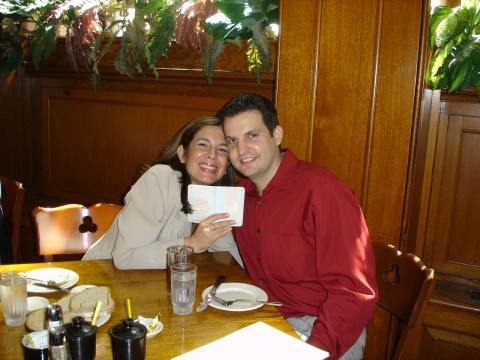
IN SUM…
The Berghoff holds special significance to me. My parents would took me to the Berghoff occasionally throughout my childhood, and it is part of the reason I learned to speak German. It was like having breakfast under the Christmas tree in Marshall Field’s Walnut Room: something special that made the trip into the city well worth it. The Berghoff was also where my wife and I celebrated the acquisition of her temporary Green Card, consisting of a stamp on her passport. Today, 17 West at the Berghoff is as popular today as the old Berghoff Restaurant ever was, as it dodged the bullet that others like Zum Deutschen Eck, Schwaben Stube, Schulien’s, and Von Stuke’s, were unable to avoid. If you like 17 West, you’ll also want to visit Resi’s Bierstube, Laschet’s, the Chicago Brauhaus, and Mirabell, who also excel in Teutonic cuisine. For more information, including a menu and details on their Chicago O’Hare location, check out the Berghoff website. Auf wiedersehen!
“Downtown Chicago has many excellent restaurants, but the Berghoff always had a special place because of its location, its atmosphere, its reasonable prices and its longevity. I think I speak for a great many Chicagoans when I say I’m sorry to see it go.”
– Mayor Richard Daley (December 2005)
